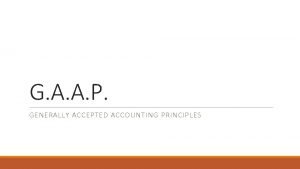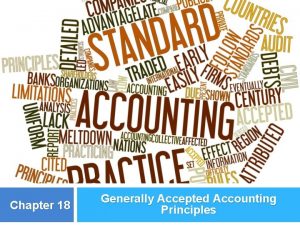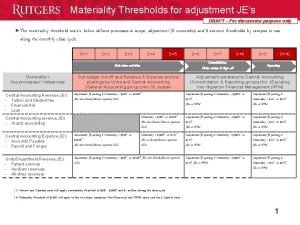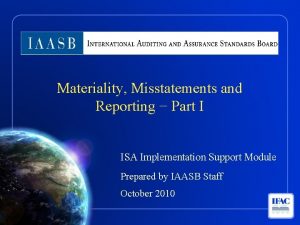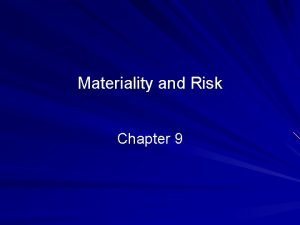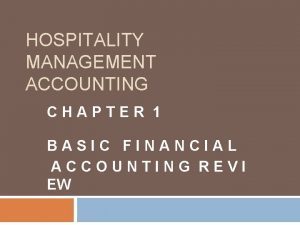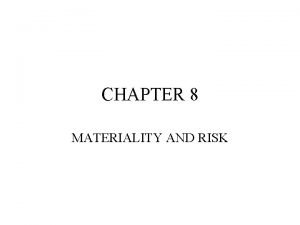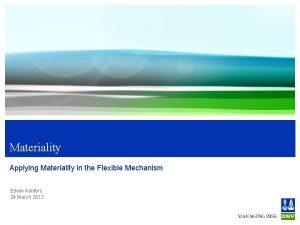MATERIALITY INTRODUCTION Understand the uses of materiality throughout






















- Slides: 22

MATERIALITY

INTRODUCTION • Understand the uses of materiality throughout the audit process • Be able to determine and use materiality throughout the audit.

GROUP EXERCISE • Read handout • Discuss in your group • Plenary 5 min. 10 min. 15 min

APPLICATION OF OVERALL MATERIALITY • To establish the threshold for determining whether the financial statements are free from material misstatement, whether due to error or fraud • Used to identify material financial statement items • Used as a basis for determining performance materiality • Used to evaluate impact of uncorrected misstatements on the financial statements and the type of audit opinion to be issued.

BENCHMARK FACTORS • What the entity is about (its mandate), • What drives the entity, • What is important to users of the entity’s financial statements, • The environment within which it operates, the entity’s financing structure, etc. • It is expected that the same benchmark will be used consistently from one year to the next; i. e. materiality should not differ significantly from one year to the next. ( stable figure)

SELECTION OF PERCENTAGES • Factors that may affect the identification of an appropriate benchmark include the following: • "The elements of the financial statements (for example, assets, liabilities, equity, revenue, expenses); • Whethere are items on which the attention of the users of the particular entity’s financial statements tends to be focused (for example, for the purpose of evaluating financial performance users may tend to focus on profit, revenue or net assets); • The nature of the entity, where the entity is in its life cycle, and the industry and economic environment in which the entity operates; • "The entity’s ownership structure and the way it is financed (for example, if an entity is financed solely by debt rather than equity, users may put more emphasis on assets, and claims on them, than on the entity’s earnings); " • Relative volatility of the benchmark

• Basis used for overall materiality Less Adjustments Equals Amount used to calculate overall materiality

OVERALL MATERIALITY Appropriate benchmark X applicable percentage

PERFORMANCE MATERIALITY • To provide for a buffer to reduce the probability that the total of uncorrected and undetected misstatements in the financial statements exceeds the overall materiality level. • Used for determining the nature, timing and extent of audit procedures to be performed. •

CALCULATION OF PERFORMANCE MATERIALITY • The performance materiality is identified as a percentage of the overall materiality. • The percentage used to calculate performance materiality is based on the conclusions on the risk of material misstatement on a financial statement level

CONT • Performance materiality = Overall materiality x % assessed level of RMM

GROUP EXERCISE OVERALL MATERIALITY • Read handout • Discuss in your group • Plenary 5 min. 10 min. 15 min

SPECIFIC MATERIALITY • A matter well below the quantitative materiality level may be determined as material based on the nature of the item or the circumstances related to the misstatement

INDICATORS FOR NEED TO USE SPECIFIC MATERIALITY • When law, regulation or the applicable financial reporting framework affects users’ expectations regarding the measurement or disclosure of certain items (for example, related party transactions, and the remuneration of management and those charged with governance). • Key disclosures are required for the entity (for example, research and development costs, consultancy costs etc. ). • Whe n the attention of the user is focused on a particular aspect of the entity’s operations that is separately disclosed in the financial statements (for example, a newly acquired mine or hospital, or census performed in the year etc. ).

CONT • The existence of a fraud by management (however immaterial) would likely be significant to financial statement users; • Where emphasis is placed on the issue by applicable laws and regulations and the compliance to it. For example, overspending may be deemed material irrespective of the amounts involved; and • If the matter(s) in the public’s interest or the sensitivity of the matter. In some cases, the fact that there is a need for legislative oversight and regulation in a particular area. • Sensitive payments, i. e. remuneration to top management The percentages used to calculated specific materiality are the same as used for overall materiality

CALCULATION OF SPECIFIC MATERIALITY • Specific materiality = Amount used for specific X applicable percentage • Performance materiality = Specific materiality X % assessed level of RMM

GROUP EXERCISE SPECIFIC MATERIALITY • Read handout • Discuss in your group • Plenary 5 min. 10 min. 15 min

CLEARLY TRIVIAL THRESHOLD • Amounts that are clearly inconsequential, whether taken individually or in aggregate and whether judged by any criteria of size, nature or circumstances • Clearly trivial misstatements would not need to be accumulated because it is expected that the accumulation of such amounts clearly would not have a material effect on the financial statements.

CLEARLY TRIVIAL THRESHOLD • The purpose of setting a level for clearly trivial is to indicate to the audit team what to look for and what not to look for and thus focusing on the material areas and bigger findings. • Overall materiality X 1 percent

RESTATEMENT OF MATERIALITY Overall materiality is revised when: – Final financial statements are received – Change in the policy of the SAI Performance materiality is revised when: – Change in assessed risks at financial statement level – Nature and extent of misstatements found when performing further audit procedures – Change in understanding of the entity


CONTACT US info@afrosai-e. org. za +27 (0)10 286 0104 www. afrosai-e. org. za
 Menentukan materialitas audit
Menentukan materialitas audit To understand recursion you must understand recursion
To understand recursion you must understand recursion What reaction does akira most fear from chie
What reaction does akira most fear from chie Materiality principal
Materiality principal Weighted average inventory cost method
Weighted average inventory cost method Materiality concept
Materiality concept Basic accountin
Basic accountin Cost constraint in accounting
Cost constraint in accounting Materiality threshold
Materiality threshold Calculate overall materiality
Calculate overall materiality Isa on materiality
Isa on materiality Preliminary materiality
Preliminary materiality Materiality
Materiality The materiality constraint
The materiality constraint Hình ảnh bộ gõ cơ thể búng tay
Hình ảnh bộ gõ cơ thể búng tay Slidetodoc
Slidetodoc Bổ thể
Bổ thể Tỉ lệ cơ thể trẻ em
Tỉ lệ cơ thể trẻ em Chó sói
Chó sói Tư thế worm breton
Tư thế worm breton Chúa yêu trần thế alleluia
Chúa yêu trần thế alleluia Kể tên các môn thể thao
Kể tên các môn thể thao Thế nào là hệ số cao nhất
Thế nào là hệ số cao nhất



